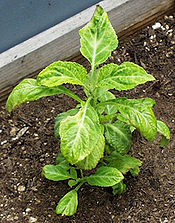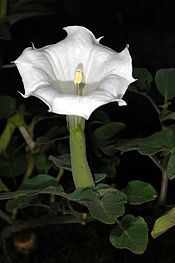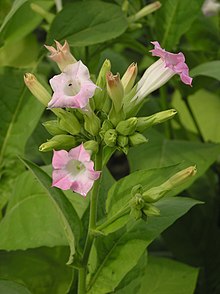Hallucinogen
This article has multiple issues. Please help improve it or discuss these issues on the talk page. (Learn how and when to remove these template messages)
|
Hallucinogens are a large and diverse class of
Etymology
The word hallucinogen is derived from the word hallucination.[3] The term hallucinate dates back to around 1595–1605, and is derived from the Latin hallūcinātus, the past participle of (h)allūcināri, meaning "to wander in the mind."[4]
Characteristics
Leo Hollister gave five criteria for classifying a drug as hallucinogenic.[5][6] This definition is broad enough to include a wide range of drugs and has since been shown to encompass a number of categories of drugs with different pharmacological mechanisms and behavioral effects.[6] Richard Glennon has thus given an additional two criteria that narrow the category down to classical hallucinogens.[6] Hollister's criteria for hallucinogens were as follows:[5][6]
- in proportion to other effects, changes in thought, perception, and mood should predominate;
- intellectual or memory impairment should be minimal;
- stupor, narcosis, or excessive stimulation should not be an integral effect;
- autonomic nervous system side effects should be minimal; and
- addictive craving should be absent.
Glennon's additional criteria for classical hallucinogens are that the drugs in question must also:[6]
- bind at 5-HT2 serotonin receptors; and
- be recognized by animals trained to discriminate the drug DOM from vehicle.
Nomenclature and taxonomy
Most hallucinogens can be categorized based on their pharmacological mechanisms as
Classical hallucinogens or psychedelics have been described by many names. David E. Nichols wrote in 2004:[8]
Many different names have been proposed over the years for this drug class. The famous German toxicologist Louis Lewin used the name phantastica earlier in this century, and as we shall see later, such a descriptor is not so farfetched. The most popular names—hallucinogen, psychotomimetic, and psychedelic ("mind manifesting")—have often been used interchangeably. Hallucinogen is now, however, the most common designation in the scientific literature, although it is an inaccurate descriptor of the actual effects of these drugs. In the lay press, the term psychedelic is still the most popular and has held sway for nearly four decades. Most recently, there has been a movement in nonscientific circles to recognize the ability of these substances to provoke mystical experiences and evoke feelings of spiritual significance. Thus, the term entheogen, derived from the Greek word entheos, which means "god within", was introduced by Ruck et al. and has seen increasing use. This term suggests that these substances reveal or allow a connection to the "divine within". Although it seems unlikely that this name will ever be accepted in formal scientific circles, its use has dramatically increased in the popular media and on internet sites. Indeed, in much of the counterculture that uses these substances, entheogen has replaced psychedelic as the name of choice and we may expect to see this trend continue.
Robin Carhart-Harris and Guy Goodwin write that the term psychedelic is preferable to hallucinogen for describing classical psychedelics because of the term hallucinogen's "arguably misleading emphasis on these compounds' hallucinogenic properties."[10]
Certain hallucinogens are designer drugs, such as those in the 2C and 25-NB (NBOMe) families.[11] A designer drug is a structural or functional analog of a controlled substance (hallucinogenic or otherwise) that has been designed to mimic the pharmacological effects of the original drug while at the same time avoid being classified as illegal (by specification as a research chemical) and/or avoid detection in standard drug tests.[12]
Effects by type
Psychedelics (classical hallucinogens)

Despite several attempts that have been made, starting in the 19th and 20th centuries, to define common phenomenological structures (i.e., patterns of experience) brought on by classical psychedelics, a universally accepted taxonomy does not yet exist.[13][14]
A prominent element of psychedelic experiences is visual alteration.[13] Psychedelic visual alteration often includes spontaneous formation of complex flowing geometric visual patterning in the visual field.[14] When the eyes are open, the visual alteration is overlaid onto the objects and spaces in the physical environment; when the eyes are closed the visual alteration is seen in the "inner world" behind the eyelids.[14] These visual effects increase in complexity with higher dosages, and also when the eyes are closed.[14] The visual alteration does not normally constitute hallucinations, because the person undergoing the experience can still distinguish between real and internally generated visual phenomena, though in some cases, true hallucinations are present.[13] More rarely, psychedelic experiences can include complex hallucinations of objects, animals, people, or even whole landscapes.[13]
A number of studies by
Link R. Swanson divides overarching scientific frameworks for understanding psychedelic experiences into two waves. In the first wave, encompassing nineteenth- and twentieth-century frameworks, he includes model
Dissociatives

Dissociatives produce analgesia, amnesia and catalepsy at anesthetic doses.[22] They also produce a sense of detachment from the surrounding environment, hence "the state has been designated as dissociative anesthesia since the patient truly seems disassociated from his environment."[23] Dissociative symptoms include the disruption or compartmentalization of "...the usually integrated functions of consciousness, memory, identity or perception."[24]p. 523 Dissociation of sensory input can cause derealization, the perception of the outside world as being dream-like, vague or unreal. Other dissociative experiences include depersonalization, which includes feeling dissociated from one's personality; feeling unreal; feeling able to observe one's actions but not actively take control; being unable to associate with one's self in the mirror while maintaining rational awareness that the image in the mirror is the same person.[25] In a 2004 paper, Daphne Simeon offered "...common descriptions of depersonalisation experiences: watching oneself from a distance (similar to watching a movie); candid out-of-body experiences; a sense of just going through the motions; one part of the self acting/participating while the other part is observing;...."[26]
The classical dissociatives achieve their effect through blocking binding of
Some dissociatives can have
Many users of dissociatives have been concerned about the possibility of NMDA antagonist
In 1989,
Deliriants





Deliriants, as their name implies, induce a state of
Despite the fully legal status of several common deliriant plants, deliriants are largely unpopular as recreational drugs due to the severe, generally unpleasant and often dangerous nature of the hallucinogenic effects produced.[39][page needed]
Typical or classical deliriants are those which are
Uncured tobacco is also a deliriant due to its intoxicatingly high levels of nicotine.[43]
History of use
Traditional religious and shamanic use
Historically, hallucinogens have been commonly used in religious or
Shamans consume hallucinogenic substances in order to induce a trance. Once in this trance, shamans believe that they are able to communicate with the spirit world, and can see what is causing their patients' illness. The Aguaruna of Peru believe that many illnesses are caused by the darts of sorcerers. Under the influence of yaji, a hallucinogenic drink, Aguaruna shamans try to discover and remove the darts from their patients.[46]
In the 1970s, Frida G. Surawicz and Richard Banta published a review of two case studies where hallucinogenic drug use appeared to play a role in "delusions of being changed into a wolf" (sometimes referred to as "
Early scientific investigations
In an 1860 book, the mycologist
Hallucinogens after World War II
After World War II there was an explosion of interest in hallucinogenic drugs in
At the beginning of the 1950s, the existence of hallucinogenic drugs was virtually unknown to the general public in the
As early as the 1960s, research into the medicinal properties of LSD was being conducted. "Savage et al. (1962) provided the earliest report of efficacy for a hallucinogen in OCD, where after two doses of LSD, a patient who suffered from depression and violent obsessive sexual thoughts experienced dramatic and permanent improvement (Nichols 2004: 164)."[8]
Starting in the mid-20th century, psychedelic drugs have received extensive attention in the Western world. They have been and are being explored as potential therapeutic agents in treating alcoholism,[54] and other forms of drug addiction.[55][56][57]
Legal status and attitudes
In the United States, classical hallucinogens (psychedelics) are in the most strictly prohibited class of drugs, known as Schedule 1 drugs.
The
Effects
Relationship between long-term use and mental illness
No clear connection has been made between psychedelic drugs and organic brain damage. However, hallucinogen persisting perception disorder (HPPD) is a diagnosed condition wherein certain visual effects of drugs persist for a long time, sometimes permanently,[61] although the underlying cause and pathology remains unclear.[62]
A large epidemiological study in the U.S. found that other than personality disorders and other substance use disorders, lifetime hallucinogen use was not associated with other mental disorders, and that risk of developing a hallucinogen use disorder was very low.[63]
A 2019 systematic review and meta-analysis by Murrie et al. found that the transition rate from a diagnosis of hallucinogen-induced psychosis to that of schizophrenia was 26% (CI 14%-43%), which was lower than cannabis-induced psychosis (34%) but higher than amphetamine (22%), opioid (12%), alcohol (10%) and sedative (9%) induced psychoses. Transition rates were not affected by sex, country of the study, hospital or community location, urban or rural setting, diagnostic methods, or duration of follow-up. In comparison, the transition rate for brief, atypical and not otherwise specified psychosis was found to be 36%.[64]
Effects on the brain
Different classes of hallucinogens have different pharmacological mechanisms of action.[2][65] Psychedelics are 5-HT2A receptor agonists (serotonin 2A receptor agonists).[66][65]
LSD, mescaline, psilocybin, and PCP are drugs that cause hallucinations, which can alter a person's perception of reality. LSD, mescaline, and psilocybin cause their effects by initially disrupting the interaction of nerve cells and the neurotransmitter serotonin.[67] It is distributed throughout the brain and spinal cord, where the serotonin system is involved with controlling of the behavioral, perceptual, and regulatory systems. This also includes mood, hunger, body temperature, sexual behavior, muscle control, and sensory perception. Certain hallucinogens, such as PCP, act through a glutamate receptor in the brain which is important for perception of pain, responses to the environment, and learning and memory. Thus far, there have been no properly controlled research studies on the specific effects of these drugs on the human brain, but smaller studies have shown some of the documented effects associated with the use of hallucinogens.[67]
Psychotomimetic paradigm
While early researchers believed certain hallucinogens mimicked the effects of schizophrenia, it has since been discovered that some hallucinogens resemble endogenous psychoses better than others. PCP and ketamine are known to better resemble endogenous psychoses because they reproduce both positive and negative symptoms of psychoses, while psilocybin and related hallucinogens typically produce effects resembling only the positive symptoms of schizophrenia.
Chemistry
Classical hallucinogens (psychedelics) can be divided into three main chemical classes: tryptamines (such as
See also
- Closed-eye visualization
- DOx
- Hallucinogenic plants in Chinese herbals
- Out-of-body experience
- Psychedelia
- Psychedelic experience
- Psychonautics
- Psychopharmacology
- Visual perception
References
- PMID 22033605.
- ^ S2CID 52824516.
- ^ "hallucinogen". Merriam-Webster. Retrieved 31 May 2020.
- ^ "Hallucinate". Dictionary.com. Retrieved 26 June 2020.
- ^ a b Glennon RA. Classical drugs: an introductory overview. In Lin GC and Glennon RA (eds). Hallucinogens: an update Archived 23 July 2015 at the Wayback Machine. National Institute on Drug Abuse: Rockville, MD, 1994.
- ^ S2CID 10221368.
- PMID 29224406.
- ^ PMID 14761703.
- PMID 28444578.
- PMID 28443617.
- PMID 25928069.
- PMID 21083227.
- ^ PMID 28025814.
- ^ PMID 29568270.
- S2CID 7845214.
- PMID 26442957.
- PMID 30574112.
- ^ S2CID 54467870.
- PMID 34151217.
- PMID 34423279.
- PMID 34423278.
- PMID 18730444.
- PMID 18730832.
- ^ American Psychiatric Association. Diagnostic and statistical manual of mental disorders (4th ed., text revision). Washington, DC: American Psychiatric Association, 2000.
- S2CID 10128404.
- S2CID 18506672.
- S2CID 2369250.
- PMID 6264253.
- S2CID 28576850.
- PMID 12192085.
- S2CID 72401949.
- ^ White W. (1998) This is your brain on dissociatives Archived 17 October 2010 at the Wayback Machine (accessed 23 October 2010)
- ^ Anderson C. (2003) The bad news isn't in Archived 17 December 2008 at the Wayback Machine (Accessed 23 October 2010)
- ^ White W. (2004) Response to "The Bad News Isn't In": Please Pass the Crow Archived 17 October 2010 at the Wayback Machine (accessed 23 October 2010)
- PMID 2660263.
- PMID 11803444.
- PMID 9408919.
- ISBN 978-0471041207.
- ISBN 978-0964156852.
- ^ Schultes, Richard Evans; Hofmann, Albert (1979). The Botany and Chemistry of Hallucinogens (2nd ed.). Springfield Illinois: Charles C. Thomas.
- ISBN 0-02-535480-9.
- PMID 9725967.
- ISBN 9780806132624.
- ISBN 0-307-24362-1.
- ISBN 978-0-8130-3378-5. Archived from the originalon 17 July 2011.
- JSTOR 649156.
- S2CID 27654641.
- S2CID 22105326.
- S2CID 13894582.
- ISBN 978-0812974751.
- ^ Lindsey, Brink (2007). The Age of Abundance: How Prosperity Transformed America's Politics and Culture. New York: Collins. p. 156.
...pot and psychedelics revealed to their users wildly different visions of reality from the "straight" one everybody took for granted. ... Guided into those transcendent realms, many young and impressionable minds were set aflame with visions of radical change. ... Antiwar protesters, feminists, student rebels, environmentalists, and gays all took their turns marching to the solemn strains of "We Shall Overcome"...
- ISBN 978-0812974751.
By normative social standards, something unseemly was going on, but since LSD, the catalyst that was unleashing the celebratory chaos, was still legal [in 1966], there was little [the authorities] could do... [That year, a]cross the nation, states started passing laws prohibiting LSD. .... By their panic, as expressed through their prohibitionary legislation, the conservative forces teased out what was perhaps the central countercultural progression for this epoch.
- PMID 3352236.
- from the original on 13 October 2013. Retrieved 1 July 2013.
- from the original on 13 October 2013. Retrieved 1 July 2013.
- from the original on 18 October 2013. Retrieved 26 December 2013.
- from the original on 13 October 2013. Retrieved 1 July 2013.
- ^ Smith, Craig S. (7 January 2006). "The Saturday Profile; Nearly 100, LSD's Father Ponders His 'Problem Child'". The New York Times. Archived from the original on 20 May 2011. Retrieved 22 May 2010.
- ^ "Netherlands bans magic mushrooms". BBC. 12 October 2007. Archived from the original on 13 November 2016. Retrieved 13 November 2016.
- ^ Naftulin, Julia (4 November 2020). "Oregon has become the first state to legalize 'magic' mushrooms for therapeutic use. Here's what that means". Business Insider. Retrieved 27 May 2021.
- PMID 27822679.
- PMID 35599738.
- S2CID 52821352.
- PMID 31618428.
- ^ PMID 28401524, retrieved 5 March 2022
- PMID 26841800.
- ^ a b "DrugFacts: Hallucinogens – LSD, mescaline, Psilocybin, and PCP." Drugabuse.gov. National Institute on Drug Abuse, n.d. Web. 13 April 2014. <http://www.drugabuse.gov/publications/drugfacts/hallucinogens-lsd-mescaline-psilocybin-pcp[permanent dead link]>.
- S2CID 230298.
- S2CID 13040014.
- S2CID 84901005.
- .
- ^ S2CID 28653940.
Further reading
- Ann & Alexander Shulgin: PIHKAL (Phenethylamines I Have Known And Loved), a Chemical Love Story
- Ann & Alexander Shulgin: TIHKAL (Tryptamines I Have Known And Loved), the Continuation
- Charles S. Grob, ed.: Hallucinogens, a reader
- Winkelman, Michael J., and Thomas B. Roberts (editors) (2007).Psychedelic Medicine: New Evidence for Hallucinogens as Treatments 2 Volumes. Westport, CT: Praeger/Greenwood.
External links
- Erowid is a web site dedicated entirely to providing information about psychoactive drugs, with an impressive collection of trip reports, materials collected from the web and usenet, and a bibliography of scientific literature.
- Multidisciplinary Association for Psychedelic Studies is a nonprofit research and educational organization which carries out clinical trials and other research in order to assess the potential medicinal uses of psychedelic drugs and develop them into medicines.
- PsychonautWiki[permanent dead link] is a wiki dedicated to documenting psychoactive drugs and their subjective effects, with an emphasis on hallucinogens and novel psychoactives. The site hosts experience reports, tutorials, and a curated collection of articles.

